Nathan Howard
A Conformer-based Waveform-domain Neural Acoustic Echo Canceller Optimized for ASR Accuracy
May 06, 2022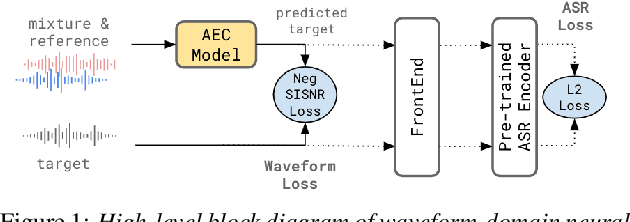
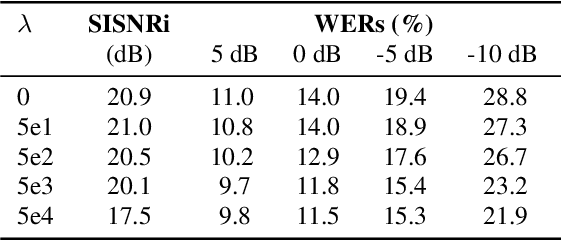
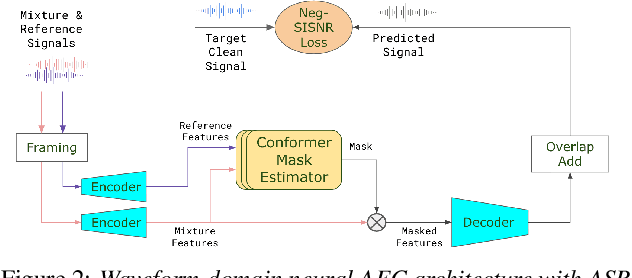

Abstract:Acoustic Echo Cancellation (AEC) is essential for accurate recognition of queries spoken to a smart speaker that is playing out audio. Previous work has shown that a neural AEC model operating on log-mel spectral features (denoted "logmel" hereafter) can greatly improve Automatic Speech Recognition (ASR) accuracy when optimized with an auxiliary loss utilizing a pre-trained ASR model encoder. In this paper, we develop a conformer-based waveform-domain neural AEC model inspired by the "TasNet" architecture. The model is trained by jointly optimizing Negative Scale-Invariant SNR (SISNR) and ASR losses on a large speech dataset. On a realistic rerecorded test set, we find that cascading a linear adaptive AEC and a waveform-domain neural AEC is very effective, giving 56-59% word error rate (WER) reduction over the linear AEC alone. On this test set, the 1.6M parameter waveform-domain neural AEC also improves over a larger 6.5M parameter logmel-domain neural AEC model by 20-29% in easy to moderate conditions. By operating on smaller frames, the waveform neural model is able to perform better at smaller sizes and is better suited for applications where memory is limited.
Mask scalar prediction for improving robust automatic speech recognition
Apr 26, 2022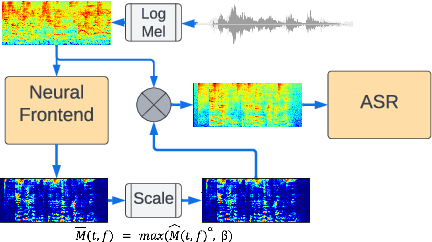

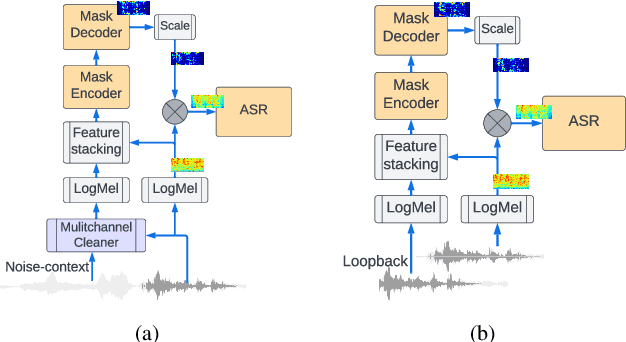

Abstract:Using neural network based acoustic frontends for improving robustness of streaming automatic speech recognition (ASR) systems is challenging because of the causality constraints and the resulting distortion that the frontend processing introduces in speech. Time-frequency masking based approaches have been shown to work well, but they need additional hyper-parameters to scale the mask to limit speech distortion. Such mask scalars are typically hand-tuned and chosen conservatively. In this work, we present a technique to predict mask scalars using an ASR-based loss in an end-to-end fashion, with minimal increase in the overall model size and complexity. We evaluate the approach on two robust ASR tasks: multichannel enhancement in the presence of speech and non-speech noise, and acoustic echo cancellation (AEC). Results show that the presented algorithm consistently improves word error rate (WER) without the need for any additional tuning over strong baselines that use hand-tuned hyper-parameters: up to 16% for multichannel enhancement in noisy conditions, and up to 7% for AEC.
A Conformer-based ASR Frontend for Joint Acoustic Echo Cancellation, Speech Enhancement and Speech Separation
Nov 18, 2021



Abstract:We present a frontend for improving robustness of automatic speech recognition (ASR), that jointly implements three modules within a single model: acoustic echo cancellation, speech enhancement, and speech separation. This is achieved by using a contextual enhancement neural network that can optionally make use of different types of side inputs: (1) a reference signal of the playback audio, which is necessary for echo cancellation; (2) a noise context, which is useful for speech enhancement; and (3) an embedding vector representing the voice characteristic of the target speaker of interest, which is not only critical in speech separation, but also helpful for echo cancellation and speech enhancement. We present detailed evaluations to show that the joint model performs almost as well as the task-specific models, and significantly reduces word error rate in noisy conditions even when using a large-scale state-of-the-art ASR model. Compared to the noisy baseline, the joint model reduces the word error rate in low signal-to-noise ratio conditions by at least 71% on our echo cancellation dataset, 10% on our noisy dataset, and 26% on our multi-speaker dataset. Compared to task-specific models, the joint model performs within 10% on our echo cancellation dataset, 2% on the noisy dataset, and 3% on the multi-speaker dataset.
A Neural Acoustic Echo Canceller Optimized Using An Automatic Speech Recognizer And Large Scale Synthetic Data
Jun 01, 2021



Abstract:We consider the problem of recognizing speech utterances spoken to a device which is generating a known sound waveform; for example, recognizing queries issued to a digital assistant which is generating responses to previous user inputs. Previous work has proposed building acoustic echo cancellation (AEC) models for this task that optimize speech enhancement metrics using both neural network as well as signal processing approaches. Since our goal is to recognize the input speech, we consider enhancements which improve word error rates (WERs) when the predicted speech signal is passed to an automatic speech recognition (ASR) model. First, we augment the loss function with a term that produces outputs useful to a pre-trained ASR model and show that this augmented loss function improves WER metrics. Second, we demonstrate that augmenting our training dataset of real world examples with a large synthetic dataset improves performance. Crucially, applying SpecAugment style masks to the reference channel during training aids the model in adapting from synthetic to real domains. In experimental evaluations, we find the proposed approaches improve performance, on average, by 57% over a signal processing baseline and 45% over the neural AEC model without the proposed changes.
 Add to Chrome
Add to Chrome Add to Firefox
Add to Firefox Add to Edge
Add to Edge